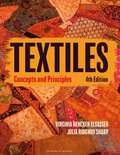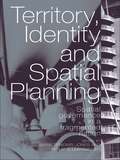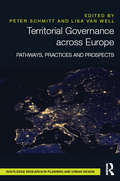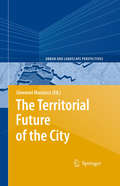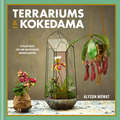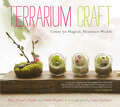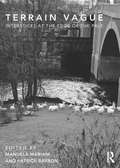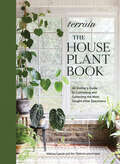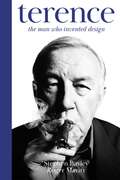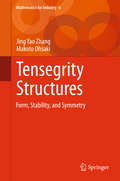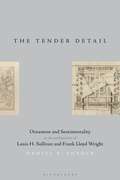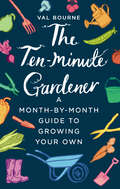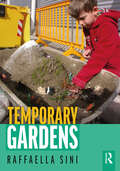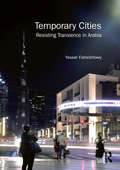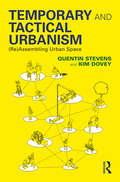- Table View
- List View
Textiles for Residential and Commercial Interiors: - with STUDIO
by MaryPaul Yates Adrienne Concra"I adopt this text due to the strong applications within the fields of Interior Design and Architecture. It shows practical knowledge that students need upon graduation. It should be kept as reference for all new graduates." Victoria Runge, University of Tennessee, Chattanooga, USALearn how to select textiles for every type of residential and commercial interior. The book has the most current fiber and fabric information about household and institutional textiles, and commercial and residential textiles for upholstered furniture, windows, walls, and floorcoverings. More than 500 color line drawings and photographs illustrate fibers, yarns, fabrics, manufacturing equipment, coloring, finishings, and end products. Textiles for Residential and Commercial Interiors STUDIO-an online study tool! · Study smarter with self-quizzes featuring scored results and personalized study tips· Review vocabulary with flashcards PLEASE NOTE: Purchasing or renting this ISBN does not include access to the STUDIO resources that accompany this text. To receive free access to the STUDIO content with new copies of this book, please refer to the book + STUDIO access card bundle ISBN 9781501326660.
Textiles for Residential and Commercial Interiors: - with STUDIO
by MaryPaul Yates Adrienne ConcraLearn how to choose the right type of textile for your residential and commercial interior design. This book includes important information about fiber and fabrics for household and institutional textiles, and commercial and residential textiles. It also touches on specific design techniques such as the latest textile printing methods and technologies, the newest performance-related finishes, proper window treatment, and the best environmentally conscious sustainability approaches. The line drawings and photographs show yarns, weaving, manufacturing equipment, fibers, fabrics used in a variety of interior spaces, and many more. New to this Edition- Updated to include the newest codes and guidelines for fabric performance and evaluation - Exploration of new textile printing methods and technologies- Updated fire safety methods and flammability testing STUDIO Features Include- Study smarter with self-quizzes featuring scored results and personalized study tips- Review concepts with flashcards of terms and definitions Instructor Resources- Instructor's Guide to help integrate the text into your classroom- PowerPoint slides for every chapter
Textiles: Concepts and Principles - with STUDIO
by Virginia Hencken Elsasser Julia Ridgway Ridgway SharpTextiles: Concepts and Principles, Fourth Edition provides a thorough approach to the fundamentals of textiles in a readable, nontechnical style, focusing on the interrelationship of textile components to help students understand and predict textile properties and performance to ultimately choose the best textile for their final product. With new co-author Julia Ridgway Sharp, Virginia Hencken Elsasser covers the global textile industry and components of textile products, summarizes laws and regulations affecting the textile industry, and looks into career possibilities, properties, care instructions, end uses of natural and manufactured fibers, yarns, fabrics, coloration and finishes, and the overall impact of textiles on the environment.New to this Edition-Updated information on sustainability, laws and regulations, and technological advancements- New Did you know? feature in each chapter provides thoughtful insights into new developments in the textile industry-Inclusion of imperial and metric measurements for a more global scopeSTUDIO Features Include-Study smarter with self-quizzes featuring scored results and personalized study tips -Review concepts with flashcards of essential vocabulary -Download additional exercises to practice your skills Instructor Resources-Instructor's Guide with Test Bank provides suggestions for planning the course and using the text in the classroom, supplemental assignments, and lecture notes-Test Bank includes sample test questions for each chapter-PowerPoint® presentations include images from the book and provide a framework for lecture and discussion
Territory, Identity and Spatial Planning: Spatial Governance in a Fragmented Nation
by Mark Tewdwr-Jones Philip AllmendingerThis book provides a multi-disciplinary study of territory, identity and space in a devolved UK, through the lens of spatial planning. It draws together leading internationally renowned researchers from a variety of disciplines to address the implications of devolution upon spatial planning and the rescaling of UK politics. Each contributor offers a different perspective on the core issues in planning today in the context of New Labour’s regional project, particularly the government’s concern with business competitiveness, and key themes are illustrated with important case studies throughout.
Territory, Identity and Spatial Planning: Spatial Governance in a Fragmented Nation
by Mark Tewdwr-Jones Philip AllmendingerThis book provides a multi-disciplinary study of territory, identity and space in a devolved UK, through the lens of spatial planning. It draws together leading internationally renowned researchers from a variety of disciplines to address the implications of devolution upon spatial planning and the rescaling of UK politics. Each contributor offers a different perspective on the core issues in planning today in the context of New Labour’s regional project, particularly the government’s concern with business competitiveness, and key themes are illustrated with important case studies throughout.
Territorial Governance across Europe: Pathways, Practices and Prospects
by Peter Schmitt Lisa Van WellThis book provides a comprehensive framework for analysing, comparing and promoting territorial governance in policy relevant research. It reveals in-depth considerations of the emergence, state-of-the art and evolution of the concept of territorial governance. A unique series of ten case studies across Europe, from neighbourhood planning in North Shields in the North East of England to climate change adaptation in the Baltic Sea Region, provides far-reaching insights into a number of key elements of territorial governance. The book draws generalised empirically-based conclusions and discusses modes of transferability of ‘good practices’. A number of suggestions are presented as to how the main findings from this book can inform theories of territorial governance and spatial policy and planning. Territorial Governance across Europe will be of considerable interest to scholars around the world who are concerned with European studies, regional policy, urban and regional planning, and human and political geography. It provides a solid debate on discourses, theories, concepts and methods around the notion of territorial governance as well as a number of empirical findings from various contexts across Europe. It specifically targets scholars involved in policy-relevant research.
Territorial Governance across Europe: Pathways, Practices and Prospects
by Peter Schmitt Lisa Van WellThis book provides a comprehensive framework for analysing, comparing and promoting territorial governance in policy relevant research. It reveals in-depth considerations of the emergence, state-of-the art and evolution of the concept of territorial governance. A unique series of ten case studies across Europe, from neighbourhood planning in North Shields in the North East of England to climate change adaptation in the Baltic Sea Region, provides far-reaching insights into a number of key elements of territorial governance. The book draws generalised empirically-based conclusions and discusses modes of transferability of ‘good practices’. A number of suggestions are presented as to how the main findings from this book can inform theories of territorial governance and spatial policy and planning. Territorial Governance across Europe will be of considerable interest to scholars around the world who are concerned with European studies, regional policy, urban and regional planning, and human and political geography. It provides a solid debate on discourses, theories, concepts and methods around the notion of territorial governance as well as a number of empirical findings from various contexts across Europe. It specifically targets scholars involved in policy-relevant research.
The Territorial Future of the City (Urban and Landscape Perspectives #3)
by Giovanni MacioccoThe volume brings together contributions by leading scholars and young academics with experience in the urban potential of the territory in situations not necessarily linked to the dense metropolis, its compact form or to city sprawl. What brings these scholars together is their common reflection on this central theme, though from varied disciplinary and experimental backgrounds. They offer new forms of representing social and spatial processes of the contemporary society.
Terrariums & Kokedama
by Alyson MowatTerrariums, aeriums and kokedama (Japanese for 'moss ball') have exploded in popularity and making them at home is surprisingly easy and a wonderful way to keep plants in our homes. In this inspirational guide, Alyson Mowat shares her creative ideas for greening up your home and workspace, with 20 projects to make your own botanical beauties and containers to show them off. Alyson guides you through the information and tools you'll need to help cultivate your green thumb, before sharing her tips for making your own unique containers, such as a concrete planter or kokedama tray, choosing the best plants for your space and desired effort, and even includes tips to propagate them. With names such as Through the Looking Glass, Plant-O-Saurus and Hung Up on You, the projects are fun and quirky, bringing the outside in. With Alyson's keen, stylish eye, you can create chic, low-maintenance greenery to cover your home or work.
Terrarium Craft: Create 50 Magical, Miniature Worlds
by Amy Bryant Aiello Kate BryantIf you&’ve always wanted to have a bit of nature in your own home, without the worry and labor of a garden, this book will show you exactly how to create your own unique, enchanting world inside a terrarium.
Terrain Vague: Interstices at the Edge of the Pale
by Patrick Barron Manuela MarianiAs planners and designers have turned their attentions to the blighted, vacant areas of the city, the concept of "terrain vague," has become increasingly important. Terrain Vague seeks to explore the ambiguous spaces of the city -- the places that exist outside the cultural, social, and economic circuits of urban life. From vacant lots and railroad tracks, to more diverse interstitial spaces, this collection of original essays and cases presents innovative ways of looking at marginal urban space, with studies from the United States, Europe and the Middle East, from a diverse group of planners, geographers, and urban designers. Terrain Vague is a cooperative effort to redefine these marginal spaces as a central concept for urban planning and design. Presenting innovative ways of looking at marginal urban space, and focusing on its positive uses and aspects, the book will be of interest to all those wishing to understand our increasingly complex everyday surroundings, from planners, cultural theorists, and academics, to designers and architects.
Terrain Vague: Interstices at the Edge of the Pale
by Manuela Mariani Patrick BarronAs planners and designers have turned their attentions to the blighted, vacant areas of the city, the concept of "terrain vague," has become increasingly important. Terrain Vague seeks to explore the ambiguous spaces of the city -- the places that exist outside the cultural, social, and economic circuits of urban life. From vacant lots and railroad tracks, to more diverse interstitial spaces, this collection of original essays and cases presents innovative ways of looking at marginal urban space, with studies from the United States, Europe and the Middle East, from a diverse group of planners, geographers, and urban designers. Terrain Vague is a cooperative effort to redefine these marginal spaces as a central concept for urban planning and design. Presenting innovative ways of looking at marginal urban space, and focusing on its positive uses and aspects, the book will be of interest to all those wishing to understand our increasingly complex everyday surroundings, from planners, cultural theorists, and academics, to designers and architects.
Terrain: An Insider's Guide to Cultivating and Collecting the Most Sought-After Specimens
by Melissa Lowrie&“An informative and inspiring guide to collecting and growing plants at home.&”—Gardenista &“This book is a must-have!&”—Hilton Carter, author of Wild at Home, Wild Interiors, and Wild CreationsSecrets of the Houseplant Hunters Terrain&’s plant experts travel the world in search of the most unusual and interesting houseplants. In this inspiring and practical guide, they share their favorite specimens: exotic and eclectic ferns, like the skeleton fork, a primitive (and unfussy) predecessor to the family; new aroids to feed that monstera obsession; and adventurous trailing plants like dischidia, which is found cascading from tree branches in its native Thailand; plus succulents and cacti, indoor trees, the best low-care plants, and &“rule breakers&” like bamboo muhly grass that can make an unexpected move indoors. Along the way, Terrain introduces their favorite independent growers—passionate plant lovers who are creating new hybrids and bringing back old-school specimens to the market. And readers learn Terrain&’s way of styling and overarching philosophy on care: the most important thing we can give our plants is our presence.
Terence: The Man Who Invented Design
by Roger Mavity Stephen BayleyTerence Conran, a visionary and a myopic. A design entrepreneur and imaginative restaurateur, he was a democratising idealist who was also a selfish hedonist. His influence is everywhere in modern Britain from where we live to what we eat. Terence: The Man Who Invented Design is the most definitive, intimate and revelatory biography of this design legend, by two of his closest collaborators, Roger Mavity and Stephen Bayley. Frank, amusing, indiscreet, sharp, rude, respectful and knowing, it tells Terence's story as it evolved, from before Habitat's humble chicken brick to Bibendum's sophisticated poulet de Bresse, via personal successes and corporate calamities, culminating in that peculiar temple to the religion he invented: The Design Museum. It celebrates Terence's genius and immeasurable impact on British life - and ensures his rightful status as national treasure. Terence: The Man Who Invented Design is the most candid, up-close insight into the man and myth.
Tensegrity Structures: Form, Stability, and Symmetry (Mathematics for Industry #6)
by Jing Yao Zhang Makoto OhsakiTo facilitate a deeper understanding of tensegrity structures, this book focuses on their two key design problems: self-equilibrium analysis and stability investigation. In particular, high symmetry properties of the structures are extensively utilized. Conditions for self-equilibrium as well as super-stability of tensegrity structures are presented in detail. An analytical method and an efficient numerical method are given for self-equilibrium analysis of tensegrity structures: the analytical method deals with symmetric structures and the numerical method guarantees super-stability. Utilizing group representation theory, the text further provides analytical super-stability conditions for the structures that are of dihedral as well as tetrahedral symmetry. This book not only serves as a reference for engineers and scientists but is also a useful source for upper-level undergraduate and graduate students. Keeping this objective in mind, the presentation of the book is self-contained and detailed, with an abundance of figures and examples.
The Tender Detail: Ornament and Sentimentality in the Architecture of Louis H. Sullivan and Frank Lloyd Wright
by Daniel E. SnyderThe Tender Detail tells a story about the repression of sentimentality through architectural ornament. The protagonists are Louis H. Sullivan and Frank Lloyd Wright, two of the most important architects and designers of ornament in American history.Exploring how both men worked to solve the problem of late nineteenth-century ornamentation, the book interweaves close readings of their buildings and writings with wide ranging discussions across the fields of architecture, sexuality, gender, and philosophy. It suggests that their solutions, while widely different, were both intimately rooted in the tender emotions of sentimentality. Viewing ornament in this way reveals much, not only about Sullivan and Wright's artistic intentions, but also about the role of affect, the value of beauty, and the agency and ontology of objects.Illuminated by personal stories from their respective autobiographies, which add a level of human interest unusual in an academic work, The Tender Detail is a readable, scholarly study which sheds fresh light on Sullivan and Wright's relationship, their work, and on the nature of ornament itself.
The Tender Detail: Ornament and Sentimentality in the Architecture of Louis H. Sullivan and Frank Lloyd Wright
by Daniel E. SnyderThe Tender Detail tells a story about the repression of sentimentality through architectural ornament. The protagonists are Louis H. Sullivan and Frank Lloyd Wright, two of the most important architects and designers of ornament in American history.Exploring how both men worked to solve the problem of late nineteenth-century ornamentation, the book interweaves close readings of their buildings and writings with wide ranging discussions across the fields of architecture, sexuality, gender, and philosophy. It suggests that their solutions, while widely different, were both intimately rooted in the tender emotions of sentimentality. Viewing ornament in this way reveals much, not only about Sullivan and Wright's artistic intentions, but also about the role of affect, the value of beauty, and the agency and ontology of objects.Illuminated by personal stories from their respective autobiographies, which add a level of human interest unusual in an academic work, The Tender Detail is a readable, scholarly study which sheds fresh light on Sullivan and Wright's relationship, their work, and on the nature of ornament itself.
The Tenants' Movement: Resident involvement, community action and the contentious politics of housing (Housing and Society Series)
by Quintin BradleyThe Tenants' Movement is both a history of tenant organization and mobilization, and a guide to understanding how the struggles of tenant organizers have come to shape housing policy today. Charting the history of tenant mobilization, and the rise of consumer movements in housing, it is one of the first cross-cultural, historical analyses of tenants’ organizations’ roles in housing policy. The Tenants' Movement shows both the past and future of tenant mobilization. The book’s approach applies social movement theory to housing studies, and bridges gaps between research in urban sociology, urban studies, and the built environment, and provides a challenging study of the ability of contemporary social movements, community campaigns and urban struggles to shape the debate around public services and engage with the unfinished project of welfare reform.
The Tenants' Movement: Resident involvement, community action and the contentious politics of housing (Housing and Society Series)
by Quintin BradleyThe Tenants' Movement is both a history of tenant organization and mobilization, and a guide to understanding how the struggles of tenant organizers have come to shape housing policy today. Charting the history of tenant mobilization, and the rise of consumer movements in housing, it is one of the first cross-cultural, historical analyses of tenants’ organizations’ roles in housing policy. The Tenants' Movement shows both the past and future of tenant mobilization. The book’s approach applies social movement theory to housing studies, and bridges gaps between research in urban sociology, urban studies, and the built environment, and provides a challenging study of the ability of contemporary social movements, community campaigns and urban struggles to shape the debate around public services and engage with the unfinished project of welfare reform.
The Ten-Minute Gardener: A month-by-month guide to growing your own (Ten-minute Gardener Ser.)
by Val BourneTHE PERFECT GIFT FOR GARDENERSWhether you have a spacious plot or a small patch in the garden, this handbook is full of tried-and-tested tips from a seasoned old hand. It offers practical month-by-month suggestions for making the most of the little time you can spare on both the coldest winter days and the long summer afternoons, with ideas to inspire even the most experienced allotment gardeners. Focusing on the essentials needed to produce a great crop, this is for those who want to but struggle to find the time to grow their own.For those who garden in snatched moments . . . *Combined and updated editions of The Ten Minute Gardener's Fruit-Growing Diary and The Ten Minute Gardener's Vegetable-Growing Diary*
Temporary Gardens
by Raffaella SiniThe last 30 years have seen a surge in temporary gardens. The flexibility and new challenges invested in non-permanent landscapes has made them a creative and stimulating testing ground for professionals and impromptu designers. Raffaella Sini examines the historical evolution of the genre, exploring theory, narratives, and strategies informing 80 temporary gardens built in France, Germany, Spain, Portugal, Italy, the United Kingdom, Belgium, Switzerland, Sweden, New Zealand, Canada, Singapore, and the United States. Key topics include: • temporary gardens in 1970s avant-garde art and 1980s public art; • temporary gardens as opportunities to work with live processes, practice inclusion, and explore concepts of social justice and ecology; • temporary gardens to redefine the vocabulary of garden design; and • temporary gardens in tactical urbanism. The book comprehensively decodifies the full range of ephemeral gardens: uprooted, mobile, itinerant, movable, postmodern, installation, exhibited, conceptual, theme, pop-up, guerrilla, grassroots, meanwhile, interim, provisional, activist, community, and parklet. Beyond physical duration, time-focused design in gardens affects the entire process of conceiving, building, experiencing, and managing green spaces; using short-term formats, anyone can invent, trial, and experiment in a condensed experience of landscape. The temporary garden emerges as critical cultural ground for the discourse in landscape architecture, art, ephemeral urbanism, and in urban, landscape, and garden design. It is inspirational reading for designers and students alike.
Temporary Gardens
by Raffaella SiniThe last 30 years have seen a surge in temporary gardens. The flexibility and new challenges invested in non-permanent landscapes has made them a creative and stimulating testing ground for professionals and impromptu designers. Raffaella Sini examines the historical evolution of the genre, exploring theory, narratives, and strategies informing 80 temporary gardens built in France, Germany, Spain, Portugal, Italy, the United Kingdom, Belgium, Switzerland, Sweden, New Zealand, Canada, Singapore, and the United States. Key topics include: • temporary gardens in 1970s avant-garde art and 1980s public art; • temporary gardens as opportunities to work with live processes, practice inclusion, and explore concepts of social justice and ecology; • temporary gardens to redefine the vocabulary of garden design; and • temporary gardens in tactical urbanism. The book comprehensively decodifies the full range of ephemeral gardens: uprooted, mobile, itinerant, movable, postmodern, installation, exhibited, conceptual, theme, pop-up, guerrilla, grassroots, meanwhile, interim, provisional, activist, community, and parklet. Beyond physical duration, time-focused design in gardens affects the entire process of conceiving, building, experiencing, and managing green spaces; using short-term formats, anyone can invent, trial, and experiment in a condensed experience of landscape. The temporary garden emerges as critical cultural ground for the discourse in landscape architecture, art, ephemeral urbanism, and in urban, landscape, and garden design. It is inspirational reading for designers and students alike.
Temporary Cities: Resisting Transience in Arabia (Planning, History and Environment Series)
by Yasser ElsheshtawyAre Arab Gulf cities, the likes of Dubai, Abu Dhabi or Doha, on their way to extinction? Is their fate obsolescence? Or, are they the model for our urban future? Can a city whose very existence is predicated on an imported labour force who build and operate these gleaming urban centres remain a viable urban entity? Could the transient nature of this urban model, its temporariness and precariousness, also be its doom? In this wide-ranging book Yasser Elsheshtawy takes on these tough, but necessary, questions aiming to examine the very nature of the Arab Gulf city and whether it can sustain its existence throughout the twenty-first century. Having lived in the region for more than two decades he researched its marginalized and forgotten urban settings, trying to understand how a temporary people can live in a place that inherently refuses to give them the possibility of becoming citizens. By being embedded in these spaces and reconciling their presence with his own personal encounters with transience, he discovered a resilience and defiance against the forces of the hegemonic city. Using subtle acts of resistance, these temporary inhabitants have found a way to sustain and create a home, to set down roots in the midst of a fast changing and transient urbanity. Their stories, recounted in this book through case studies and in-depth analysis, give hope to cities everywhere. Transience is not a fait accompli: rather the actions of citizens, residents and migrants – even in the highly restrictive spaces of the Gulf – show us that the future metropolis may very well not turn out to be a ‘utopia of the few and a dystopia of the many’. This could be an illusion, but it is a necessary illusion because the alternative is irrelevance.
Temporary Cities: Resisting Transience in Arabia (Planning, History and Environment Series)
by Yasser ElsheshtawyAre Arab Gulf cities, the likes of Dubai, Abu Dhabi or Doha, on their way to extinction? Is their fate obsolescence? Or, are they the model for our urban future? Can a city whose very existence is predicated on an imported labour force who build and operate these gleaming urban centres remain a viable urban entity? Could the transient nature of this urban model, its temporariness and precariousness, also be its doom? In this wide-ranging book Yasser Elsheshtawy takes on these tough, but necessary, questions aiming to examine the very nature of the Arab Gulf city and whether it can sustain its existence throughout the twenty-first century. Having lived in the region for more than two decades he researched its marginalized and forgotten urban settings, trying to understand how a temporary people can live in a place that inherently refuses to give them the possibility of becoming citizens. By being embedded in these spaces and reconciling their presence with his own personal encounters with transience, he discovered a resilience and defiance against the forces of the hegemonic city. Using subtle acts of resistance, these temporary inhabitants have found a way to sustain and create a home, to set down roots in the midst of a fast changing and transient urbanity. Their stories, recounted in this book through case studies and in-depth analysis, give hope to cities everywhere. Transience is not a fait accompli: rather the actions of citizens, residents and migrants – even in the highly restrictive spaces of the Gulf – show us that the future metropolis may very well not turn out to be a ‘utopia of the few and a dystopia of the many’. This could be an illusion, but it is a necessary illusion because the alternative is irrelevance.
Temporary and Tactical Urbanism: (Re)Assembling Urban Space
by Quentin Stevens Kim DoveyTemporary and Tactical Urbanism examines a key set of urban design strategies that have emerged in the twenty-first century. Such projects range from guerrilla gardens and bike lanes to more formalised temporary beaches and swimming pools, parklets, pop-up plazas and buildings and container towns. These practices enable diverse forms of economic, social and artistic life that are usually repressed by the fixities of urban form and its management. This book takes a thematic approach to explore what the scope of this practice is, and understand why it has risen to prominence, how it works, who is involved, and what its implications are for the future of city design and planning. It critically examines the material, social, economic and political complexities that surround and enable these small, ephemeral urban interventions. It identifies their short-term and long-term implications for urban intensity, diversity, creativity and adaptability. The book's insights into temporary and tactical urbanism have particular relevance in the context of the COVID-19 pandemic, which has highlighted both the need and the possibility of quickly transforming urban spaces worldwide. They also reveal significant lessons for the long-term planning and design of buildings, landscapes and cities.


